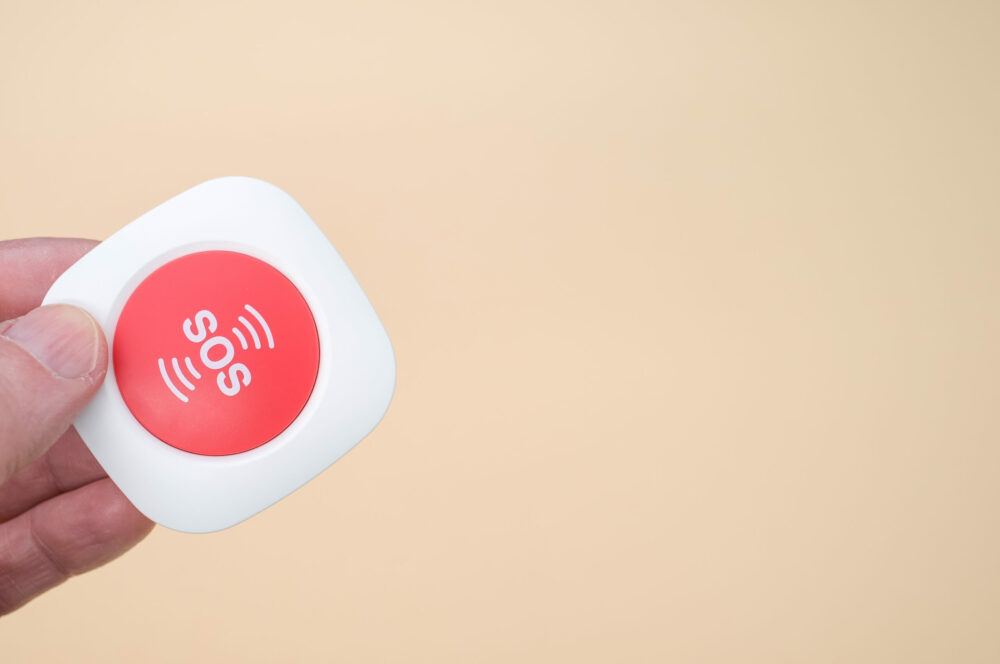Panic alarms and mobile duress systems/apps continue to play an important role in hospital, school, college and university security and safety initiatives. More than 80% of the nearly 200 participants in this year’s Panic Alarm and Mobile Duress System/App survey indicate their organization uses some type of duress signaling system.
This high rate of adoption by campuses has been driven by many factors. Recent high-profile incidents that received national attention, such as the Robb Elementary School mass shooting, the adoption of Alyssa’s law by several states, and the skyrocketing rate of workplace violence at hospitals across the country all are motivating factors in educational and healthcare facilities acquiring these systems, according to last year’s deep dive on the topic.
So once again, Campus Safety asked campus protection professionals what they currently have and what they plan on adopting soon. Also, participants were asked how the technologies they’ve adopted are performing.
New to this year’s Panic Alarm and Mobile Duress System/App survey were questions on system age, frequency of use, how duress signals are sent, system testing and more.
Demand for Fixed Panic Buttons and Mobile Duress Systems Increasing
The most popular type of technology continues to be fixed panic buttons/alarm systems, with nearly two in three respondents (65%) saying they currently have this technology. When broken down by sector, however, the responses vary significantly, with 57% of K-12 respondents saying they have this type of solution, compared to 69% of institutions of higher education, and 92% of hospitals.
Half (50%) of all of this year’s survey takers said they are considering acquiring this type of system in the next two years. That’s 28 percentage points more than respondents from last year’s survey. In the 2023 Panic Alarm and Mobile Duress System/App survey, only 22% of participants said they were considering purchasing new or additional fixed panic alarm systems.
At 68%, healthcare respondents are the most likely to currently be in the market for this type of solution, followed by colleges/universities at 49%, and K-12 schools/school districts at 42%.
Just over half (51%) of all 2024 respondents say their organization has a mobile phone app for panic alarms and emergency communications, which is 7% less than last year. Nearly six in ten (59%) of this year’s higher ed respondents say their campuses have this technology, compared to 49% of K-12 schools/districts and 45% of healthcare facilities. One in two of all 2024 survey takers (49%) are considering buying this type of solution by 2026.
At 55%, hospitals are the most interested in acquiring mobile phone panic alarm apps. K-12 campuses aren’t far behind at 51%, followed by higher education facilities at 47%.
Two in five survey participants (41%) have mobile panic button/alarm systems on pendants… exactly the same as in 2023.
When broken down by campus type, at 68%, hospitals are the respondents most likely to have this technology, compared to 42% of schools/districts, and 29% of colleges and universities.
There is a significant increase in respondents considering the purchase of mobile panic alarms on pendants in the next two years — from 26% last year to 42% this year. At 75%, hospitals are the most likely to say they are considering the acquisition of this technology by 2026, compared to 39% of K-12 schools and 29% of institutions of higher education.
Do Panic Alarms Work?
Organizations that have some type of panic alarm system are generally quite pleased with their performance. Nearly two in five respondents (39%) who have fixed panic buttons rate this technology’s performance as excellent, and 31% rate it as good. However, last year, 75% of respondents rated their fixed systems’ performance as excellent or good, which is five percentage points more than this year.
Additionally, there has been a 10-percentage point drop this year in survey participants who rate the performance of their mobile panic buttons on pendants as excellent or good: from 80% last year to 70% this year. Thirty-four percent of 2024 respondents rate the performance of their mobile panic button/alarm systems on pendants as excellent, and 36% rate it as good.
Download the report & survey participant comments
Mobile phone app users are the most satisfied with their systems: 37% rate the performance of this technology as excellent and 42% rate it as good. Their satisfaction levels with this technology remain nearly the same as in 2023.
Being that fixed panic buttons/alarms systems have been around the longest, it’s not surprising that survey participants say this is the oldest panic alarm technology on their campus. Forty two percent say their fixed panic button/alarm system is seven years old or older, compared to only 7% of respondents who say their mobile phone app for panic alarms and communications was that old.
Nearly two in three respondents (63%) whose organization has adopted a mobile phone app for panic alarms say their systems are either new (20%) or one to three years old (43%). Half of respondents whose campuses have adopted mobile panic button/alarm systems on pendants say their systems are less than three years old.
Frequency of Usage Depends on Campus Type
Mobile panic buttons on pendants are the panic alarm systems used/activated most frequently by respondents. One in five organizations (21%) that have this type of technology say they use it daily, 10% use it weekly, and 20% use it monthly.
However, when broken down by sector, hospital respondents say they use their fixed panic buttons and mobile panic alarms on pendants much more frequently. Half say their organizations use these technologies daily or weekly. This is understandable considering the extremely high rate of workplace violence that happens at hospitals.
When healthcare respondents are removed from the response data, 12% of K-12 campuses and 15% of institutions of higher education use their fixed panic buttons daily or weekly. Most schools and colleges that have this type of system activate it monthly or a few times per year.
Schools and institutions of higher education also use their mobile duress pendants less than hospitals, with 16% of educational campuses using them daily or weekly. More than half of K-12 and higher ed respondents (52%) say their organizations use their mobile duress pendants monthly or a few times per year.
Usage of mobile phone apps for panic alarms is similar among K-12 schools, colleges, and healthcare facilities, with 18% saying they use this technology daily or weekly. Over half (55%) use it monthly or a few times per year.
Is the Panic Alarm Signal Getting Through?
Considering that fixed panic buttons/alarm systems — most of which are wired — are the most used panic alarm technologies, it’s not surprising that at 54%, “wired connection” is the most common way duress signals are sent when a panic alarm system is used or activated.
Coming in right behind “wired connection” is “cellular and Wi-fi networks” at 52%, followed by “Wi-fi network” at 29%. “Cellular network” brings up the rear at 27%.
It should be noted that all four of these methods have their pros and cons. Wired systems are probably the most reliable way of delivering a duress signal. However, these systems require a user to be in one location, thus limiting an employee’s ability to walk around a classroom or hospital emergency department. Additionally, construction or building layout challenges may make it impossible for an organization to install a wired system.
“I detest fixed panic alarm systems – expensive to implement and maintain – time consuming to test and maintain – whenever offices move, we have to redeploy,” says one survey participant. “There are cheaper, better alternatives.”
Download the report & survey participant comments
For organizations that can’t use a wired system either because they need their staff members to be mobile or due to building layout constraints, a wireless solution might be the best choice. These systems enable employees, such as teachers or nurses, to carry panic button pendants or mobile phone apps with them as they work.
However, cellular and Wi-fi networks aren’t always reliable due to coverage issues, or perhaps the network is overloaded or down for some other reason.
“Mobile panic buttons are highly dependent on the building construction material, as concrete and steel drastically interfere with signals,” says another respondent.
These challenges can be addressed to a certain extent with repeaters and antennas, but it is wise for a system to have two or more ways for panic alarm signals to be transmitted.
Another challenge with wireless systems is that pendants can be lost or forgotten at home by users.
False Alarms Are Not Too Troublesome for Most
Seventeen percent of all survey participants who have fixed duress alarms or mobile panic buttons on pendants experience false alarms daily or weekly.
“We often see false alarms when people think the button is for releasing a door or it’s hit by someone’s knee,” says a survey participant.
Mobile phone apps are much less prone to false alarms with only 5% of respondents saying their systems experience this issue daily or weekly.
The good news is that most respondents say their systems rarely or never experience false alarms: 65% with fixed panic buttons, 59% of campuses with mobile panic buttons, and 89% with mobile phone panic alarm apps say their systems rarely or never experience accidental activations.
Infrequent System Testing Poses Significant Risk
Although OSHA says employers should test employee alarm systems at least annually for reliability and adequacy, other security experts recommend these devices be tested much more often… even every month.
Frequently testing a panic alarm system allows a school, university, or hospital to verify:
- The signals are going through when the button is pushed
- If the equipment requires batteries for operation, the batteries still work
- The signals are being sent to the correct people, either onsite or offsite, such as to law enforcement, fire, etc.
- The system doesn’t have any dead zones
- Users know how to operate the equipment
- The campus community knows how to respond when the system is activated
A high percentage of all of this year’s survey participants only test their panic alarms twice per year or less: 39% of respondents who have fixed panic buttons; 23% of respondents with mobile panic buttons on pendants; and 40% of respondents with mobile phone apps for panic alarms say they only test their systems twice per year, yearly, or never.
Considering all the benefits of frequent system testing, as well as the risks assumed when testing isn’t done or is done infrequently, organizations need to ask themselves if their testing frequency is adequate. This question is particularly important for organizations that only use their systems a few times per year or almost never.
Download the report & survey participant comments
Campus Safety thanks the nearly 200 campus protection professionals who completed our survey. We truly appreciate your input!
Sponsored by:












